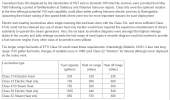Another question related to time I spent at Woking back in the 80s.
Can anyone remember the typical diagramming of the 50s on the Exeters? In particular, how did they get "on and off" the SWML, was it at the Waterloo end or the Exeter end?
CWNs reveal that the coaching stock typically turned around at Waterloo and formed the next available down service. However CWNs do not show loco movements.
Did the inbound 50 follow the inbound stock out, sit at Clapham for a while, and then come back into Waterloo for the following outbound service? Or did something more complex happen such as light engine movements to and from OOC to get the locos to and from their home Western Region? Were there any diagrams that would do an Exeter-Waterloo, and then later in the day (after refuelling, perhaps?) work something out of Paddington?
I can't remember offhand the exact patterns: I seem to remember they were a bit irregular and unpredictable. You saw a fair few 50s during the day if you spent time at Woking.
More generally, there are a few CWNs dotted around the internet, mostly on groups.io, but are there any records anywhere of loco diagramming from the 80s (or any other 'modern' era?)
Thanks.
Can anyone remember the typical diagramming of the 50s on the Exeters? In particular, how did they get "on and off" the SWML, was it at the Waterloo end or the Exeter end?
CWNs reveal that the coaching stock typically turned around at Waterloo and formed the next available down service. However CWNs do not show loco movements.
Did the inbound 50 follow the inbound stock out, sit at Clapham for a while, and then come back into Waterloo for the following outbound service? Or did something more complex happen such as light engine movements to and from OOC to get the locos to and from their home Western Region? Were there any diagrams that would do an Exeter-Waterloo, and then later in the day (after refuelling, perhaps?) work something out of Paddington?
I can't remember offhand the exact patterns: I seem to remember they were a bit irregular and unpredictable. You saw a fair few 50s during the day if you spent time at Woking.
More generally, there are a few CWNs dotted around the internet, mostly on groups.io, but are there any records anywhere of loco diagramming from the 80s (or any other 'modern' era?)
Thanks.

